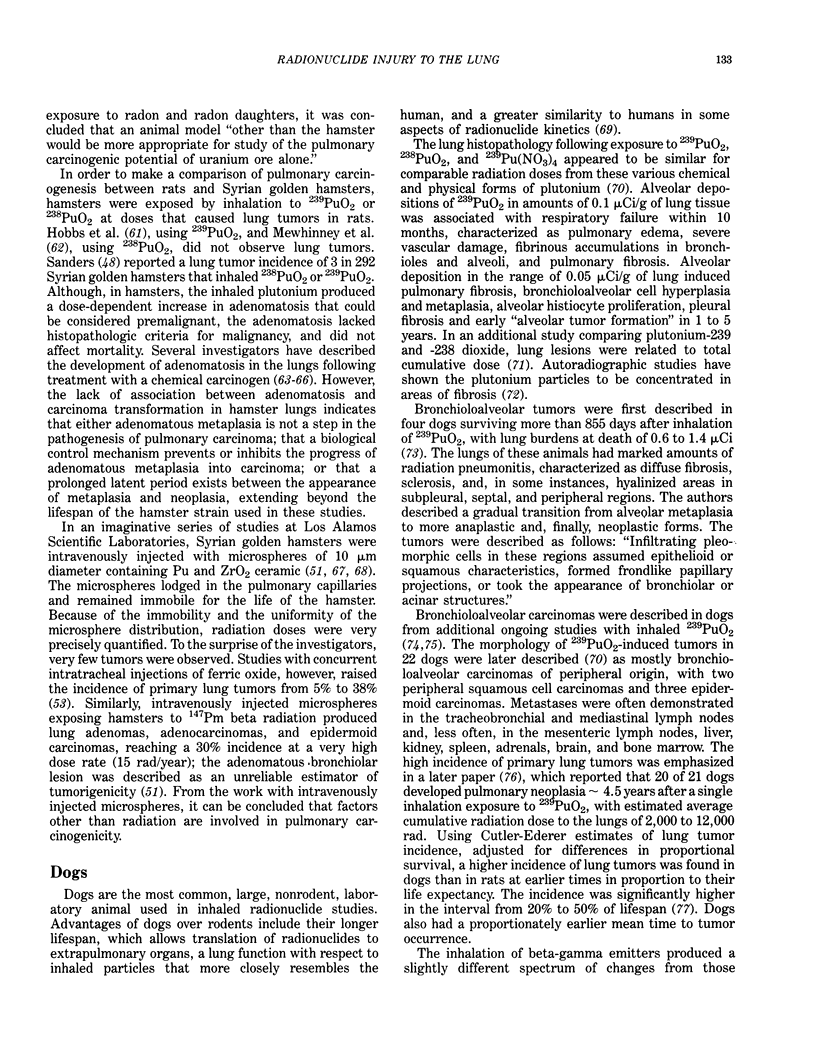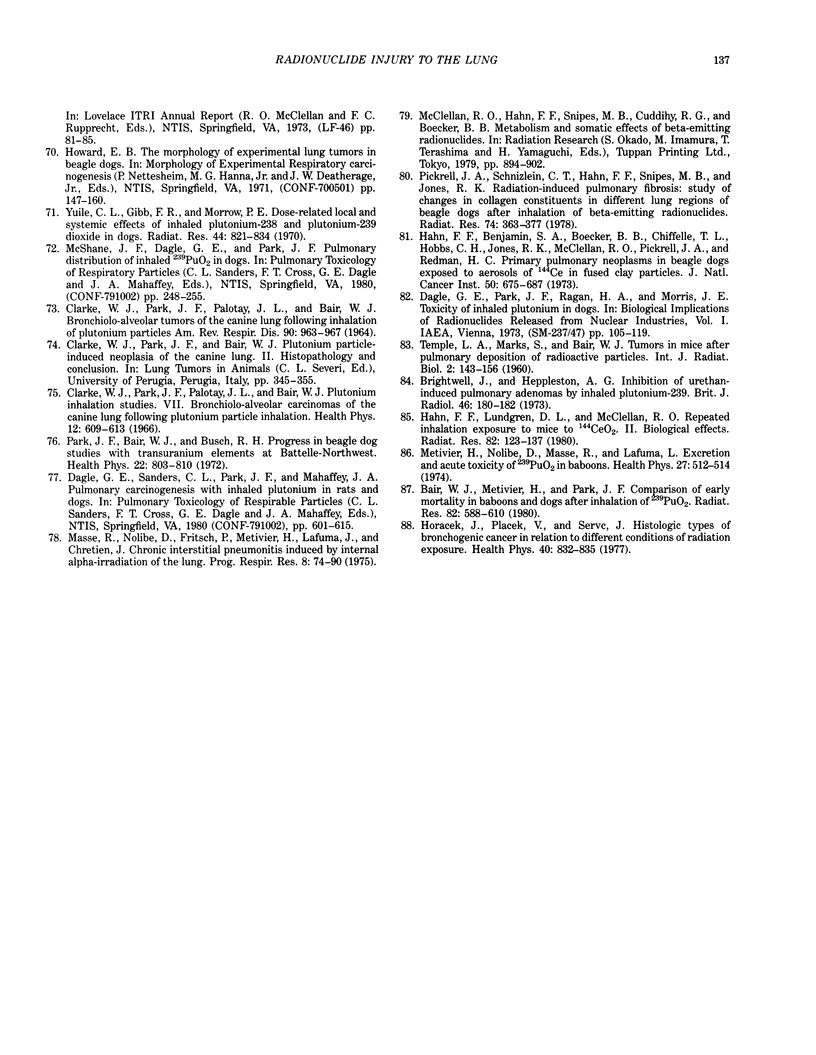Abstract
Radionuclide injury to the lung has been studied in rats, hamsters, dogs, mice and baboons. Exposure of the lung to high dose levels of radionuclides produces a spectrum of progressively more severe functional and morphological changes, ranging from radiation pneumonitis and fibrosis to lung tumors. These changes are somewhat similar for different species. Their severity can be related to the absorbed radiation dose (measured in rads) produced by alpha, beta or gamma radiation emanating from various deposited radionuclides. The chemicophysical forms of radionuclides and spatial-temporal factors are also important variables. As with other forms of injury to the lung, repair attempts are highlighted by fibrosis and proliferation of pulmonary epithelium. Lung tumors are the principal late effect observed in experimental animals following pulmonary deposition of radionuclides at dose levels that do not result in early deaths from radiation pneumonitis or fibrosis. The predominant lung tumors described have been of epithelial origin and have been classified, in decreasing frequency of occurrence, as adenocarcinoma, bronchioloalveolar carcinoma, epidermoid carcinomas and combined epidermoid and adenocarcinoma. Mesothelioma and fibrosarcoma have been observed in rats, but less commonly in other species. Hemangiosarcomas were frequency observed in dogs exposed to beta-gamma emitters, and occasionally in rats exposed to alpha emitters. These morphologic changes in the lungs of experimental animals were reviewed and issues relevant to the prediction of human hazards discussed.
Full text
PDF








Selected References
These references are in PubMed. This may not be the complete list of references from this article.
- Adee R. R., Sanders C. L., Berlin J. D. Subcellular localization and identification of alpha emitters by electron microscopic autoradiography. Health Phys. 1968 Nov;15(5):461–463. [PubMed] [Google Scholar]
- Anderson E. C., Holland L. M., Prine J. R., Smith D. M. Tumorigenic hazard of particulate alpha activity in Syrian hamster lungs. Radiat Res. 1979 Apr;78(1):82–97. [PubMed] [Google Scholar]
- Archer V. E., Lundin F. E., Jr Radiogenic lung cancer in man: exposure-effect relationship. Environ Res. 1967 Dec;1(4):370–383. doi: 10.1016/0013-9351(67)90026-6. [DOI] [PubMed] [Google Scholar]
- BOUTWELL R. K. SOME BIOLOGICAL ASPECTS OF SKIN CARCINOGENISIS. Prog Exp Tumor Res. 1964;4:207–250. doi: 10.1159/000385978. [DOI] [PubMed] [Google Scholar]
- Bair W. J., Metivier H., Park J. F. Comparison of early mortality in baboons and dogs after inhalation of 239PuO2. Radiat Res. 1980 Jun;82(3):588–610. [PubMed] [Google Scholar]
- Bair W. J., Thompson R. C. Plutonium: biomedical research. Science. 1974 Feb 22;183(4126):715–722. doi: 10.1126/science.183.4126.715. [DOI] [PubMed] [Google Scholar]
- Ballou J. E., Dagle G. E., Morrow W. G. The long-term effects of intratracheally instilled 253EsCl3 in rats. Health Phys. 1975 Aug;29(2):267–272. doi: 10.1097/00004032-197508000-00004. [DOI] [PubMed] [Google Scholar]
- Blenkinsopp W. K. Proliferation of respiratory tract epithelium in the rat. Exp Cell Res. 1967 Apr;46(1):144–154. doi: 10.1016/0014-4827(67)90416-8. [DOI] [PubMed] [Google Scholar]
- Brightwell J., Heppleston A. G. Inhibition of urethane-induced pulmonary adenomas by inhaled plutonium-239. Br J Radiol. 1973 Mar;46(543):180–182. doi: 10.1259/0007-1285-46-543-180. [DOI] [PubMed] [Google Scholar]
- CEMBER H., STEMMER K. LUNG CANCER FROM RADIOACTIVE CERIUM CHLORIDE. Health Phys. 1964 Feb;10:43–48. doi: 10.1097/00004032-196402000-00003. [DOI] [PubMed] [Google Scholar]
- CLARKE W. J., PARK J. F., PALOTAY J. L., BAIR W. J. BRONCHIOLO-ALVEOLAR TUMORS OF THE CANINE LUNG FOLLOWING INHALATION OF PLUTONIUM PARTICLES. Am Rev Respir Dis. 1964 Dec;90:963–967. doi: 10.1164/arrd.1964.90.6.963. [DOI] [PubMed] [Google Scholar]
- Clarke W. J., Park J. F., Palotay J. L., Bair W. J. Plutonium inhalation studies. VII. Bronchiolo-alveolar carcinomas of the canine lung following plutonium particle inhalation. Health Phys. 1966 May;12(5):609–613. doi: 10.1097/00004032-196605000-00003. [DOI] [PubMed] [Google Scholar]
- Cross F. T., Palmer R. F., Busch R. H., Filipy R. E., Stuart B. O. Development of lesions in Syrian golden hamsters following exposure to radon daughters and uranium ore dust. Health Phys. 1981 Jul;41(1):135–153. doi: 10.1097/00004032-198107000-00012. [DOI] [PubMed] [Google Scholar]
- DEVILLIERS A. J., WINDISH J. P. LUNG CANCER IN A FLUORSPAR MINING COMMUNITY. I. RADIATION, DUST, AND MORTALITY EXPERIENCE. Br J Ind Med. 1964 Apr;21:94–109. doi: 10.1136/oem.21.2.94. [DOI] [PMC free article] [PubMed] [Google Scholar]
- Diel J. H., Short R. K. Collagen localization in lung parenchyma irradiated by inhaled 238PuO2 particles. Radiat Res. 1979 Aug;79(2):417–423. [PubMed] [Google Scholar]
- Ehrlich R. Effect of nitrogen dioxide on resistance to respiratory infection. Bacteriol Rev. 1966 Sep;30(3):604–614. doi: 10.1128/br.30.3.604-614.1966. [DOI] [PMC free article] [PubMed] [Google Scholar]
- Feron V. J. Respiratory tract tumors in hamsters after intratracheal instillations of benzo(a)pyrene alone and with furfural. Cancer Res. 1972 Jan;32(1):28–36. [PubMed] [Google Scholar]
- HERROLD K. M., DUNHAM L. J. Induction of tumors in the Syrian hamster with diethylnitrosamine (N-nitrosodiethylamine). Cancer Res. 1963 Jun;23:773–777. [PubMed] [Google Scholar]
- Hahn F. F., Lundgren D. L., McClellan R. O. Repeated inhalation exposure of mice to 144CeO2. II. Biologic effects. Radiat Res. 1980 Apr;82(1):123–137. [PubMed] [Google Scholar]
- Homburger F. Chemical carcinogenesis in the Syrian golden hamster. A review. Cancer. 1969 Feb;23(2):313–338. doi: 10.1002/1097-0142(196902)23:2<313::aid-cncr2820230209>3.0.co;2-m. [DOI] [PubMed] [Google Scholar]
- Horácek J., Placek V., Sevc J. Histologic types of bronchogenic cancer in relation to different conditions of radiation exposure. Cancer. 1977 Aug;40(2):832–835. doi: 10.1002/1097-0142(197708)40:2<832::aid-cncr2820400235>3.0.co;2-o. [DOI] [PubMed] [Google Scholar]
- Kennedy A. R., McGandy R. B., Little J. B. Histochemical, light and electron microscopic study of polonium-210 induced peripheral tumors in hamster lungs: evidence implicating the Clara cell as the cell of origin. Eur J Cancer. 1977 Nov;13(11):1325–1340. doi: 10.1016/0014-2964(77)90043-3. [DOI] [PubMed] [Google Scholar]
- Kennedy A. R., McGundy R. B., Little J. B. Serial sacrifice study of pathogenesis of 210Po-induced lung tumors in Syrian golden hamsters. Cancer Res. 1978 Apr;38(4):1127–1135. [PubMed] [Google Scholar]
- LASKIN S., KUSCHNER M., ALTSHULER B., NELSON N. TISSUE REACTIONS AND DOSE RELATIONSHIPS IN RATS FOLLOWING INTRAPULMONARY BETA RADIATION. Health Phys. 1964 Dec;10:1229–1233. doi: 10.1097/00004032-196412000-00044. [DOI] [PubMed] [Google Scholar]
- Little J. B., Kennedy A. R., McGandy R. B. Lung cancer induced in hamsters by low doses of alpha radiation from polonium-210. Science. 1975 May 16;188(4189):737–738. doi: 10.1126/science.1124396. [DOI] [PubMed] [Google Scholar]
- Little J. B., McGandy R. B., Kennedy A. R. Interactions between polonium-210 alpha-radiation, benzo(a)pyrene, and 0.9% NaCl solution instillations in the induction of experimental lung cancer. Cancer Res. 1978 Jul;38(7):1929–1935. [PubMed] [Google Scholar]
- Little J. B., O'Toole W. F. Respiratory tract tumors in hamsters induced by benzo(a)pyrene and 210Po alpha-radiation. Cancer Res. 1974 Nov;34(11):3026–3039. [PubMed] [Google Scholar]
- Lutz M., Nolibe D., Petavy G., Rannaud J. C. Contribution à l'étude de la rétention et de l'épuration pulmonaire d'oxyde de plutonium. Etude ultrastructurale des macrophages alvéolaires. Arch Mal Prof. 1970 Apr-May;31(4):185–196. [PubMed] [Google Scholar]
- McDowell E. M., McLaughlin J. S., Merenyl D. K., Kieffer R. F., Harris C. C., Trump B. F. The respiratory epithelium. V. Histogenesis of lung carcinomas in the human. J Natl Cancer Inst. 1978 Aug;61(2):587–606. [PubMed] [Google Scholar]
- Metivier H., Masse R., Legendre N., Lafuma J. Pulmonary connective tissue modifications induced by internal alpha irradiation. I. Effect of time and dose on alterations following inhalation of plutonium-239 dioxide aerosol in rat. Radiat Res. 1978 Aug;75(2):385–396. [PubMed] [Google Scholar]
- Mole R. H. Ionizing radiation as a carcinogen: practical questions and academic pursuits The Silvanus Thompson Memorial Lecture delivered at The British Institute of Radiology on April 18, 1974. Br J Radiol. 1975 Mar;48(567):157–169. doi: 10.1259/0007-1285-48-567-157. [DOI] [PubMed] [Google Scholar]
- Nolibe D. Etude morphologique, par microcinématographie et microscopie électronique de balayage, de l'histiocyte alvéolaire après phagocytose, in vitro, d'oxyde de plutonium. C R Acad Sci Hebd Seances Acad Sci D. 1973 Jan 3;276(1):65–68. [PubMed] [Google Scholar]
- Park J. F., Bair W. J., Busch R. H. Progress in beagle dog studies with transuranium elements at Battelle-Northwest. Health Phys. 1972 Jun;22(6):803–810. doi: 10.1097/00004032-197206000-00041. [DOI] [PubMed] [Google Scholar]
- Pickrell J. A., Harris D. V., Benjamin S. A., Cuddihy R. G., Peleger R. C., Mauderly J. L. Pulmonary collagen metabolism after lung injury from inhaled 90Y in fused clay particles. Exp Mol Pathol. 1976 Aug;25(1):70–81. doi: 10.1016/0014-4800(76)90018-6. [DOI] [PubMed] [Google Scholar]
- Pickrell J. A., Harris D. V., Mauderly J. L., Hahn F. F. Altered collagen metabolism in radiation-induced interstitial pulmonary fibrosis. Chest. 1976 Feb;69(2 Suppl):311–316. doi: 10.1378/chest.69.2.311. [DOI] [PubMed] [Google Scholar]
- Pickrell J. A., Schnizlein C. T., Hahn F. F., Snipes M. B., Jones R. K. Radiation-induced pulmonary fibrosis: study of changes in collagen constituents in different lung regions of beagle dogs after inhalation of beta-emitting radionuclides. Radiat Res. 1978 May;74(2):363–377. [PubMed] [Google Scholar]
- Sanders C. L., Adee R. R., Jackson T. A. Fine structure of alveolar areas in the lung following inhalation of 239PuO2 particles. Arch Environ Health. 1971 May;22(5):525–533. doi: 10.1080/00039896.1971.10665895. [DOI] [PubMed] [Google Scholar]
- Sanders C. L., Adee R. R. Ultrastructural localization of inhaled 239PuO2 particles in alveolar epithelium and macrophages. Health Phys. 1970 Mar;18(3):293–295. [PubMed] [Google Scholar]
- Sanders C. L., Dagle G. E., Cannon W. C., Craig D. K., Powers G. J., Meier D. M. Inhalation carcinogenesis of high-fired 239PuO2 in rats. Radiat Res. 1976 Nov;68(2):349–360. [PubMed] [Google Scholar]
- Sanders C. L., Dagle G. E., Cannon W. C., Powers G. J., Meier D. M. Inhalation carcinogenesis of high-fired 238PuO2 in rats. Radiat Res. 1977 Sep;71(3):528–546. [PubMed] [Google Scholar]
- Sanders C. L. Inhalation toxicology of 238PuO2 and 239PuO2 in Syrian golden hamsters. Radiat Res. 1977 May;70(2):334–344. [PubMed] [Google Scholar]
- Sanders C. L., Mahaffey J. A. Inhalation carcinogenesis of high-fired 244CmO2 in rats. Radiat Res. 1978 Nov;76(2):384–401. [PubMed] [Google Scholar]
- TEMPLE L. A., MARKS S., BAIR W. J. Tumours in mice after pulmonary deposition of radioactive particles. Int J Radiat Biol Relat Stud Phys Chem Med. 1960 Apr;2:143–156. doi: 10.1080/09553006014550161. [DOI] [PubMed] [Google Scholar]
- TOTH B., TOMATIS L., SHUBIK P. Multipotential carcinogenesis with urethan in the Syrian golden hamster. Cancer Res. 1961 Dec;21:1537–1541. [PubMed] [Google Scholar]
- Thomas R. G., Smith D. M. Lung tumors from PuO2-ZrO2 aerosol particles in Syrian hamsters. Int J Cancer. 1979 Nov 15;24(5):594–599. doi: 10.1002/ijc.2910240512. [DOI] [PubMed] [Google Scholar]
- Thompson R. C. Plutonium--health implications for man. Animal data on plutonium toxicity. Health Phys. 1975 Oct;29(4):511–519. doi: 10.1097/00004032-197510000-00007. [DOI] [PubMed] [Google Scholar]
- WAGONER J. K., ARCHER V. E., LUNDIN F. E., Jr, HOLADAY D. A., LLOYD J. W. RADIATION AS THE CAUSE OF LUNG CANCER AMONG URANIUM MINERS. N Engl J Med. 1965 Jul 22;273:181–188. doi: 10.1056/NEJM196507222730402. [DOI] [PubMed] [Google Scholar]
- Yuile C. L., Gibb F. R., Morrow P. E. Dose-related local and systemic effects of inhaled plutonium-238 and plutonium-239 dioxide in dogs. Radiat Res. 1970 Dec;44(3):821–834. [PubMed] [Google Scholar]


